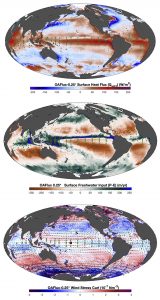
About
Objective
The OAFlux project aims to provide high-quality climate data records of air-sea heat, freshwater, and momentum fluxes for use in studies of the global energy budget, water cycle, atmosphere and ocean circulation, climate change and variability.
Approach
The OAFlux project applies the state-of-art techniques including machine learning tools to derive insights from satellite and in situ observations in developing the best strategy for air-sea flux estimation.
Ongoing projects
- 60 Year Global Ocean Surface Heat Flux Analysis - sponsored by NOAA GOMO
This project aims to produce a high-quality, long-term, global air-sea flux climate record. The project is established on the basis that flux estimates can be improved only when uncertainties in data and flux algorithms are skillfully treated. Three approaches are pursued simultaneously to enable improved flux estimation on a global scale: (i) mathematical optimization of a variety of global-scale data sources to reduce the uncertainty in one single source, (ii) advancing satellite retrieval skills for near-surface thermodynamic state variables (air temperature and humidity), and (iii) using air-sea time series measurements from 140+ OceanSITES Reference Stations as benchmarks for calibration, validation, and quality assurance of the project products. Currently, the project has produced global time series of ocean latent and sensible heat fluxes, ocean evaporation, and flux-related surface meteorology from 1958 to present. Two updates are provided each year.
- Earth System Data Records of Air-Sea Variables and Fluxes Anchored on Global Moored-Buoy Observations - sponsored by NASA MeaSUREs
This project is to produce, validate, and distribute Earth System Data Records (ESDRs) of air-sea variables and turbulent fluxes on 0.25° spatial resolution for the period from 1987 onward. The specific air-sea ESDRs include (i) near ocean-surface wind speed (w) and components (zonal (u) and meridional (v)) merged from scatterometers and microwave radiometers; (ii) near ocean-surface air temperature (Ta) retrieved and merged from microwave scanners, microwave and infrared sounders; (iii) near ocean-surface air specific humidity (qa) retrieved and merged from microwave radiometers and sounders; and (iv) air-sea turbulent momentum fluxes (zonal (τx) and meridional (τy)), latent heat flux (QLH), sensible heat flux (QSH), and moisture flux (evaporation (E)) that are computed from the state-of-the-art bulk flux parameterizations using the ESDRs of air-sea variables as input.
- Modern Satellite/in situ-based Air-Sea Turbulent Heat Flux Products
for the Arctic Ocean and Adjacent Seas - sponsored by NOAA COM
The diminishing sea ice has radically changed the seasonal patterns of turbulent exchange between the Arctic atmosphere and ocean. However, both climate model simulations and atmospheric reanalyses show difficulty in representing the surface heat fluxes associated with the growth and melt of sea ice. The large disparity in the predicted rates of Arctic sea ice loss highlights the urgent need for developing accurate satellite-based air-sea turbulent heat flux products for the Arctic Ocean to serve as validation for the modeling community. This project capitalizes on recent observing advancements made at high-latitude environments and the machine learning applications for remote sensing and will produce air-sea variable and turbulent heat flux products for the Arctic and adjacent subarctic seas (poleward of 50°N). Work is currently ongoing.
Use of OAFlux products
If you use our products in your project, we would appreciate your acknowledgement of the OAFlux project. Suggested language of acknowledgement: "This publication is based upon the WHOI OAFlux datasets supported by the NOAA’s Global Ocean Monitoring and Observing (GOMO) Program and NASA's Making Earth System Data Records for Use in Research Environments (MEaSUREs) Program". For questions, please contact us.